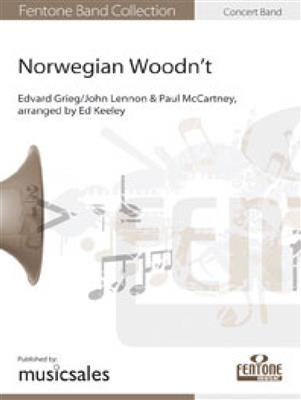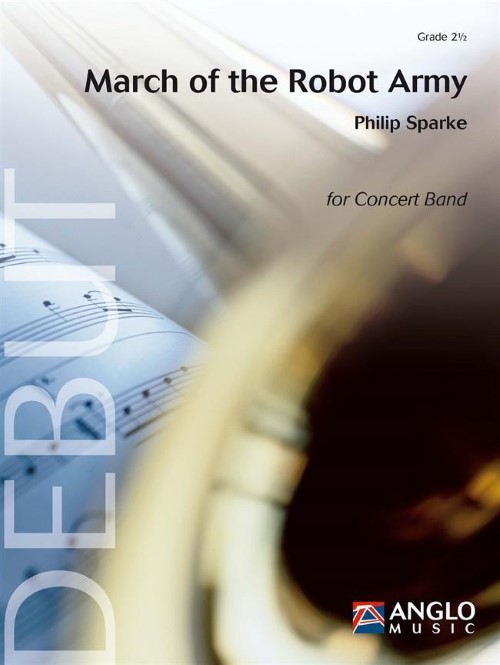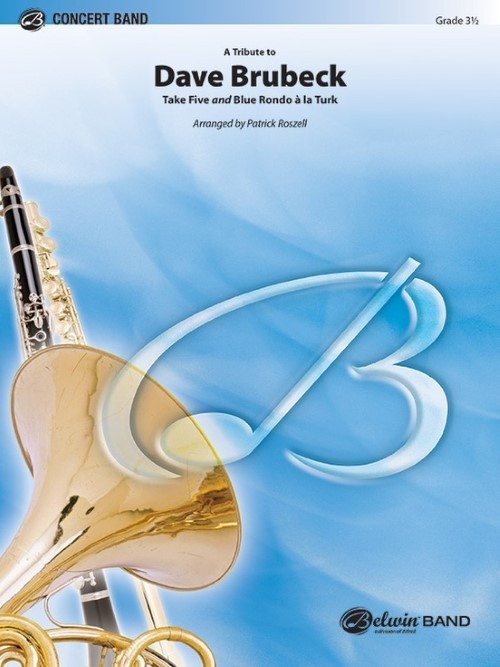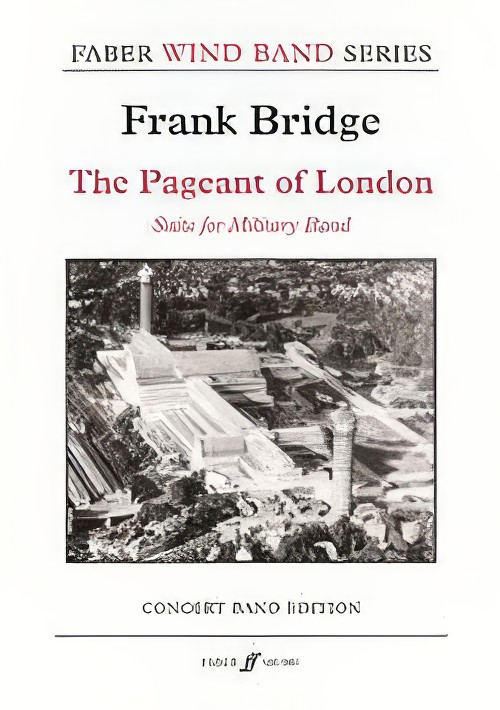Results
-
 £168.50
£168.50Trois Nuances - Scott L. Hines
TROIS NUANCES is a three movement work composed by Scott L. Hines for the Memphis Ballet Company in 2004. Originally for Piano only,it is a three movement work. The two fast movements surround a blues-like second movement. While it was not the composer's initial intent to write a movement based in the blues, that's what happened and it was very appropriate as Trois Nuances was danced on thestage of W.C. Handy Park on Beale Street, the site of the birth of the blues publishing industry. Hines was given a week to present a draft to the ballet company to be performed as it's opening piece of the 2004 season debut. Once the draft was approved, he had two days to finalize it. The first and third movements reflect the hurried and excited pace at which it was composed. Excellent repertoire from a contemporary American composer! Symphonic Orchestra. Instrument Parts. Grade: 4 Duration: 12:29
Estimated dispatch 7-14 working days
-
 £157.50
£157.50Flumen - Marco Somadossi
In October 2000, the River Po produced its highest flood waters in the last hundred years, provoking a natural disaster of dramatic dimensions. To the thousands of valiant men and women committed to defending their villages against the threat of the flood is dedicated the symphonic poem entitled "Flumen" (river, in Latin), inspired by the thematic material in the Gregorian sequence, "Victimae paschali laudes". The main melody is elaborated and its essence is transfigured in an alchemy of modern sounds from which, at times, archaic echoes emerge. The composition is structured in two parts: the first ("The River") is sullen and menacing, with sounds that portray the turbulent water and the inexorable and frightening rise of the flood;this contrasts with a second section ("The People"), with its primitive rhythms and vaguely multiethnic character (expressed through modal harmonies). Here the work evokes man's ancestral struggle against the forces of nature: the strenuous defence of the Po riverside communities to against the threat of flooding. In the finale, the two themes interweave and overlap, re-establishing a symbolic and primordial equilibrium where man and nature are again in harmony with each other.
Estimated dispatch 7-14 working days
-
 £110.00
£110.00Mount Everest - Kees Vlak
This composition basically consists of three fragments and an epilogue (conclusion):1) Plateaux, 2) Sherpas, 3) Climb. The piece starts with a musical depiction of the deserted plateauxs and mountain peaks of the Himalayas. The mysteriousness of theTibetan country was caused by its inaccessibility to other nations. One even believed that there was a paradise behind the huge mountains; the land of Shangra La. 1) After the sound of a gong, the Asian-like theme arises extremely softly from thedecay of the percussion. In bars 4 and 5 the syllables of Hi-ma-la-ya echo. Then a second theme appears; it symbolises the enchantment of the mountaineers by seeing the Mount Everest. 2) Eastern percussion, very evenly without emotion, sound from thedeserted village of the sherpas. The phrasing is prescribed by the number 'three'. From measure 56 Tibetian monks sing a chant, also with the religious background of the number 'three'. 3) The third part starts of with the sight of the giant MountEverest with an entirely new theme, that is played impressively by the strong low brass instruments of the band, immediately followed by the excited big climbing. The many surprises are depicted by the changing time signatures. Two themes are inconstant battle; the binary Himalaya theme and the ternary Mount Everest theme. Only once there is a steely composure. The registers in which the piece is played increase. The tension rises...Then the peak is reached. A long pause follows before onerealises that one is on top of the world. Slowly the emotions of joy grow and lead to an enormous climax. The first enchanted theme sounds again in total glory.
Estimated dispatch 7-14 working days
-
 £104.99
£104.99Crime Time - Les Humphries
Tatort (Scene of the Crime), Derrick and Ein Fall fr zwei (A Case for Two) are three classic crime series on German television. Two of the themes, are from the pen of Klaus Doldinger and the third theme, Derrick was written by Les Humphries, an Englishman, who had great success with the Les Humphries Singers. In Crime Scene Stefan Schwalgin has faithfully adapted the original sound of the melodies to produce a thrilling medley.
Estimated dispatch 7-14 working days
-
 £169.99
£169.99Olympica - Jan van der Roost
This "Grand Overture" was commissioned by the "Nagano Community Band" - Japan- on occasion of its jubilee in 1992 and is dedicated to the band's conductor, Ikuo Inagaki.The work is based upon three main themes, each symbolising a certain theme. The first part is characterized by its bright themes played mainly by the brass, accompanied by the woodwinds and festive percussion. This part symbolizes the jubilee which is the origin of the composition. This is followed by a bouncing allegro, in which each register of the band displays brilliant techniques. Especially the woodwinds come to the fore! This movement depicts the industriousness and enthousiasm shown by the members of the"Nagano Community Band" in the carrying out of their hobby. A third, main theme, is choral-like in character and is displayed both in the (soft) brass as well as in the warm medium register of the reeds. Here, nature's beaty in and around the city of Nagano is musically celebrated. Following a "chamber-music episode" (featuring the flute, oboe, clarinet, alto-saxophone and horn) the initial allegro re-occurs, weaving its way towards a grandiose finale, in which the two previous themes are once again apparent. Due to its very colourful scoring and the enormous diversity of musical thoughts and ideas, this composition is a fascinating and memorable piece, worthy a jubilee overture!
Estimated dispatch 7-14 working days
-
 £84.99
£84.99Toccata - Claudio Monteverdi
Claudio Monteverdi composed this toccata as an instrumental introduction for the opera L'Orfeo (1607). According to the composer, this introduction should be played three times before the rising of the curtain. This is actually the first overture in the history of opera.)The story of Orfeo, who enchanted nature with his music, is tragic, as he loses his beloved Eurydice and decides to retrieve her from the underworld. On their return journey, one glance back at her is fatal: he loses her for the second time.)This arrangement for wind band is very suitable as a concert opener. The toccata is played three times just like the original. The first time it is played by a quintetconsisting of two trumpets and three trombones.)Various ways of performing this toccata are possible. The tension builds up more intensely if the quintet starts off stage. Eventually, these five players join the band, after which the tutti version follows two times. You can also have the brass play from the gallery during the second or third time for a double choir effect.
Estimated dispatch 7-14 working days
-
 £91.99
£91.99Norwegian Woodn't - John Lennon
In Norwegian Woodn't, two extremely different but equally famousmelodies take turns. Initially, Morning Song from Grieg?s Peer GyntSuite No. 1 is presented followed by the melody of Norwegian Woodby the Beatles. The two melodies alternate a number of times andform a natural musical whole. With this work, arranger Ed Keeley hascreated a distinctive mix of classical and pop music which will thrillyour audience.
Estimated dispatch 7-14 working days
-
 £99.99
£99.99March of the Robot Army (Concert Band - Score and Parts) - Sparke, Philip
March of the Robot Army was commissioned by Linda Anzolin and Giordano-Bruno Tedeschi for Campobanda 2019, with funds made available by Just Italia. Campobanda is an Italian summer music camp for 8 to 18 year olds which has a different theme every year. The theme for 2019 was science fiction, so composer Philip Sparke chose to write a robot march. After a quirky introduction featuring trumpet calls and chromatic figures, the main theme appears in a minor mode on clarinet and tenor sax and is then taken up by the full band. A change of key heralds a new theme, led by the trumpet and again repeated by the full ensemble. A further change of key introduces a legato trio melody over a rather robotic accompaniment: instruments are added bit by bit until a climax is reached. Small motifs from the introduction then lead back to a full recapitulation, revisiting the first two themes in new guises before finishing the march with a flourish.Duration: 5.00
Estimated dispatch 7-14 working days
-
 £76.95
£76.95Dave Brubeck, A Tribute to (Concert Band - Score and Parts) - Roszell, Patrick
A Tribute to Dave Brubeck arranged by Patrick Roszell is a rhythmic tour de force for your concert band that will leave your audience breathless. Featuring two of the Dave Brubeck Quartet's best-known charts; the grooving "Take Five" and the furious "Blue Rondo ? la Turk," the flexible assignment of the brief solo sections presents a great opportunity to feature two graduating seniors. Duration: 6.15
Estimated dispatch 7-14 working days
-
 £89.99
£89.99The Pageant of London (Concert Band - Score and Parts) - Bridge, Frank
Frank Bridge was one of the finest English composers of the first half of the 20th century. The Pageant of London is his only work for wind band, comprising of two marches, one scored from Bridge's best known organ piece and including the chimes of Big Ben, plus three short renaissance pastiche items, one arranged from Playford (later used by Peter Warlock in Capriol Suite). The music is tuneful, approachable and makes a fine alternative to Holst's two suites, which were composed around the same time. Duration: 15.00
Estimated dispatch 7-14 working days
